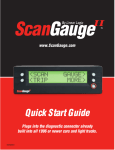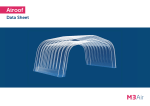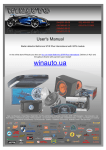Download How well do you know your vehicle?
Transcript
How well do you know your vehicle? October 2014 by: Clarence Middleton - Macon County, IL - HCE This information is presented in a quiz format for anyone that drives a vehicle with limited or zero knowledge of how to maintain it. Answers are at the end of this lesson. Don’t peek! A vehicle consists of the following major categories. 1. Body 2. Engine 3. Transmission 5. Wheels/Tires 6. Brakes 7. Exhaust 4. Fuel System 8. Electrical The BODY on cars and mini-vans no longer have a frame. Smaller pieces are welded together to make a very strong one piece unit, except for the doors, trunk lid, hood and front fenders. Why are most vehicles made of steel instead of plastic or aluminum which are lighter? a1. ___________________ a2. ___________________ a3. ____________________ The ENGINE, more commonly called a motor, is located under the hood even if the engine is in the rear of the car. The engine has many peripheral components attached to it, (which we won’t go into in this document) that can make the engine difficult to be seen. Release the hood latch, lift the hood from the front. The hood will either stay up by itself or require a prop which is in easy reach. If you can’t get the hood up, make an appointment with a reputable mechanic. What the driver/owner of a vehicle must to do periodically is: 1. Change the engine oil every 3,000 to 5,000 miles or at least once a year if you drive less. With newer Synthetic engine oils, change the oil every 5,000 to 10,000 miles. Refer to your owners manual for recommended intervals. 2. Inspect belts for cracks, hoses for leaks, battery terminals for corrosion and check all fluid levels. 3. Replace the Air Filter every 10,000 to 20,000 miles, which prevents dirt, sand, leaves, insects or small animals from getting sucked into the engine, causing friction and damage. 4. Do an occasional walk around your car to verify that all lights are working. This includes: Head, Tail, Brake, Turn Signals, License, and Side Markers. 5. Record all maintenance in a small booklet along with date and mileage. Store in the glove box. List (7) different places, under the hood, where fluids are found and need occasional checking. 1. ____________________________________________________________________ 2. ____________________________________________________________________ 3. ____________________________________________________________________ 4. ____________________________________________________________________ 5. ____________________________________________________________________ 6. ____________________________________________________________________ 7. ____________________________________________________________________ www.mchce.org The “automatic” or “manual” TRANSMISSION is very reliable and trouble free. A Manual transmission has a CLUTCH pedal to disengage the engine from the drive train. Why does the Automatic transmission not need a clutch pedal? Torque Converter How does A Torque Converter work? Why does oil from the transmission go to the radiator? A1. ________________________ A2. ________________________ Name (5) things to do, or not do to keep the transmission trouble free. 1. ______________________________________________________ 2. ______________________________________________________ 3. ______________________________________________________ 4. ______________________________________________________ 5. ______________________________________________________ Your FUEL SYSTEM is usually trouble free for 100,000 miles. It consists of a tank filled with gasoline or diesel, a filter, a fuel pump, and a carburetor or injectors. Where is the fuel pump located on most cars from 1995 to present day vehicles? A. ______________________________________________________________ Why does “diesel” cost more than “regular” gasoline? A. ______________________________________________________________ How are “Miles Per Gallon” calculated? If you are low on gas, will driving faster, get you to the gas station before you run out? A. ______________________________________________________________ What precautions should be taken before and when refueling your vehicle. A. ______________________________________________________________ The BRAKES on your car come in different types, “Disc” or “Shoe”. Disk brakes pinch on a rotating disc, Shoe brakes press against the inside of a rotating drum. Low cost vehicles come equipped with “disc” on front wheels and “shoe” on the rear. Front brakes do most of the work as weight shifts forward while stopping. Shoe brakes on the rear make excellent “emergency” brakes while vehicles with “disc” brakes front and rear don’t actually have emergency brakes. They have what are called “parking” brakes because they are tiny and have minimal stopping abilities. They are only designed to keep a car from rolling while already stopped. Disc Parking brake shoes (RED) are small and fit inside the small outer Hub Shoe www.mchce.org Why does a steering wheel shake on older cars when you press on the brake pedal? A. _____________________________________________________________ When “disc” brakes get older they make a squealing noise when braking. Why? A. _____________________________________________________________ Why did my brakes fail and the brake pedal went down to the floor? A. _____________________________________________________________ How do Anti-Lock Brakes work? A. _____________________________________________________________ TIRES come in a variety of sizes and tread patterns but all come standard with wear indicators molded into the rubber. When the tread wears down to the wear indicators, it is no longer legal or safe to drive on that tire. Why is correct tire inflation important? A. _____________________________________________________________ What is the recommended tire inflation in P.S.I. (pounds per square inch) ? A. _______________________________________________ All light vehicles manufactured after September 1, 2007 are required by law to have what special safety device installed in each wheel? A. _______________________________________________ EXHAUST systems wor k the same on all vehicles. 1. A muffler is included to reduce ______________. 2. Exhaust is transferred to the _________ of the car. 3. Name 3 pollutants that the catalytic converter reduces. a. ______________ b. _______________ c. ________________ 4. A faulty leaking exhaust system can cause _________________. INDICATOR LAMPS located in the dash are not to be ignored. The “check engine” or “service engine soon” light will illuminate when a malfunction is detected. This lamp comes on when your key is first turned, just before you start the engine, and should go out after starting. When the cars computer detects a problem, the light will come on steady or blink. This can be caused by a hundred different things from a loose gas cap to a major mechanical or electrical problem. A blinking light is considered more serious than a solid light. When this light turns on, the computer records the fault as a numbered code which can be displayed with special equipment. This code allows accurate diagnosis and your mechanic can go straight to the problem without guessing. If the problem is intermittent, the computer may reset the fault and turn off the light. www.mchce.org QUESTIONS: 1. If the “check engine” light comes on while driving, should you stop or keep going? A. ______________________________ 2. If the “oil can” light comes on while driving, should you stop or keep going? A. ______________________________ 3. If the “battery” light comes on while driving, should you stop or keep going? A. ______________________________ 4. If the “temp” light comes on while driving, should you stop or keep going? A. ______________________________ 5. What benefits does antifreeze coolant have year round, not just in the winter? A1. _______________________________________________________ A2. _______________________________________________________ A3. _______________________________________________________ 6. You are alone and have a flat tire at night. Should you drive slow to the next gas station knowing your tire will be destroyed or should you wait for help from a stranger? 7. Multi-Lane highways have a soft shoulder on the right to pull off in case of emergencies. Q. You are driving in the far left, fast lane, and your car suddenly comes to a stop before you can move right to the soft shoulder. What is the most important thing you need to do when your car comes to a stop? A. __________________________________ 8. If you are driving at 55mph with the cruise control on, what steps should you take if your gas pedal suddenly pulls itself down to the floor and your speed rapidly increases? If you have passengers, you may have more options. A1. ___________________________________________________________________ A2. ___________________________________________________________________ A3. ___________________________________________________________________ 9. If you pull off to the side of a road at night for any reason, should you leave your lights ON, OFF, or activate the EMERGENCY FLASHERS? 10 You are slowly approaching a stop sign on a slick icy street. You press on the brake pedal and your tires loose traction. You know you are not going to stop in time. What can you do to help your vehicle stop sooner? A1. ___________________________________________________________________ A2. ___________________________________________________________________ 11 While approaching a small town traveling at 55mph, a sign ahead says, “Speed Limit 30”. You de-activate your cruise control to slow down. When leaving the town, the speed limit is once again 55mph. At what speed should you re-energize your cruise control? A. ___________ www.mchce.org Answers March 2014 Body: a1. Less expensive and stronger. a2. Cars made of Plastic, Fiberglass or Aluminum don’t rust. Planned obsolescence. a3. Safety! Steel fenders, hoods and other panels absorb energy during a collision. Steel has the ability to fold like an accordion. Other materials crack or break. Engine: 1. Engine Oil 2. Transmission Oil 3. Radiator Coolant 5. Brake Fluid 6. Battery 7. Windshield Wash 4. Power Steering Oil Transmission: The torque converter takes the place of the clutch. The torque converter is filled with transmission oil. It acts like a boat propeller in the water. There are 2 propellers in the converter. The propeller connected to the engine forces oil against the propeller on the transmission. Step on the gas, and away you go. A1. Keeps the oil cool in summer. A2. Warms the oil in winter to help smooth shifting. 1. Don’t pull trailers, push another car or pull tree stumps. 2. Keep oil level at proper levels. Transmission oil must be checked warm with the engine running. An “automatic” transmission with insufficient oil can damage the internal clutches. This does not apply to “manual” transmissions. 3. Don’t shift excessively from forward to reverse when stuck in mud or snow. 4. Have the oil and filter, found inside the transmission, replaced as per service manual. Every time your transmission shifts gears, small particles are rubbed off the clutches and build up on the filter like mud. A clogged filter will prevent pump pressure. 5. In below zero temps, allow engine to warm some, which also warms the trans oil. Drive slow. You may notice the transmission shifts sluggish until warm. Fuel System: 1. The fuel pump is located deep inside the tank. This allows continuous flow of fuel which reduces a chance of iced up fuel lines in the winter. 2. Diesel fuel is actually cheaper to make because it requires less refinement. It is higher priced because of greater demand by trucks. Years ago, diesel was cheaper. 3. Fill tank, Drive, Refill tank. Divide miles driven by gallons needed to fill tank. 4. Put your left hand on your car before and inserting the pump nozzle. Do not walk away and than return to remove the nozzle. A static charge can cause a spark. Brakes: 1. Steering wheels shake while braking because the thin rotors get warped from heat causing the brake pads to touch unevenly. Rotors can be repaired or replaced. 2. The squealing noise is caused by a special piece of metal attached to the brake pad. It’s called a wear indicator letting the driver know it’s time to replace the pads before the brakes fail. (see photo at right) 3. Unlike air, fluid cannot be compressed into a smaller space. When you press on the pedal, fluid is pushed toward the wheels causing the pads to extend. When the pad reaches its end of travel, pressure is built up causing the pedal to stop halfway down. If the system has a leak, fluid will escape thru the hole and no pressure will build. The pedal will go to the floor. 4. All 4 wheels have a sensor that sends rotation speed to a computer. When brakes are applied, if the computer senses a slower rotation speed on 1 wheel, the brake on that wheel is released momentarily to allow it to rotate again. The other 3 will continue to brake. On ice you may hear or feel a buzz. That is the brake on and off action. www.mchce.org Tires: 1. A tire inflated to high will ride rough and wear the tire tread in the center. In hot weather, air inside the tire expands increasing pressure. An under inflated tire will ride soft but can cause the outside tread to wear and cause a deadly steering condition. 2. Normal tire pressure on most cars is between 32 - 38 lbs., checked when not sitting in the sun. The pressure rating on side of tire is maximum air pressure. Consult your operators manual for before filling. 3. A tire pressure sensor is mounted in the valve stem. If the tire pressure drops below 25-30 lbs., the cars computer turns on a fault light and indicates which tire is low. Exhaust: 1. Noise 2. Rear 3. Carbon monoxide (CO) is a poisonous gas that is colorless and odorless. Hydrocarbons or volatile organic compounds (VOCs) are a major component of smog produced mostly from evaporated, unburned fuel. Nitrogen oxides (NO and NO2, together called NOx) are a contributor to smog and acid rain, which also causes irritation to human mucus membranes. 4. Death. A small exhaust leak near the engine can allow carbon monoxide to enter the cabin area when the windows are up causing sleep, nausea, headaches, or death. Questions: 1. Even if your engine is running rough, but not making noise, it should get you home or to a service location. 2. Stop immediately. Turn off engine. Do not drive to the nearest gas station for oil. Major mechanical damage can occur within minutes. 3. The “battery” light is an indication that your charging system has failed, not your battery. Your car should run ok until the battery runs down. At night your headlights will grow dimmer and eventually go out. If you shut your engine off, it may not start. 4. Turn off the engine within 1 mile. This is an indication of a hot engine. A broken belt or low radiator coolant can cause high temperature. If you have no water available to add, allow the car to cool. Drive until the light returns. 5. Antifreeze coolant keeps your radiator from rusting, your water pump lubricated and gives the cooling system a higher boiling point in summer. 6. This is your decision to make. If you are by yourself and feel unsafe, driving slow should not hurt your car but may cost you the price of a new tire. You never know who may stop while your stranded. 7. You and all your passengers need to exit immediately. Flashing hazard lights are optional. It could be just a matter of seconds or minutes before your vehicle gets struck by a speeding car or truck. 8. This doesn’t happen just to a Toyota. You have about 1 minute to react before your car reaches 100mph. These recommendations may not apply to your situation. A1. Try turning off your cruise control. Pressing the brake should work but may not. A2. Slowly move the Shift lever from Drive to Neutral. Do not go to Rev or Park. Your engine may rev up high causing damage to it. A3. Turning off the ignition is risky. This action may disable safety features such as: Air Bags, or On-Star. If you turn the key too far, you will lock the steering. Steering will be difficult with engine off and brakes will not work as usual. 9. OFF or FLASHERS is good. Leaving the lights ON when stopped is unsafe. A sleepy driver sometimes will follow the car ahead. They may crash into your car. 10. With your transmission in (D) drive, your engine is still trying to pull you down the road. If you slip the shift lever to (N) neutral, you should notice a big drop in speed. Also, try moving to loose snow or rocks on side of the road for more traction. 11. You should re-energize your cruise control after accelerating to the desired speed. Re-energizing at a lower speed could result in excessive acceleration and loss of control on slick roads. www.mchce.org










